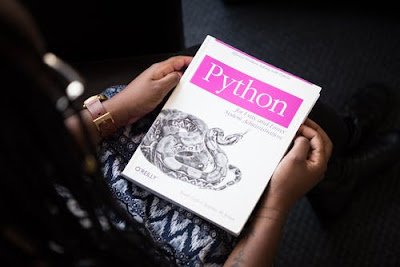
artificial intelligence
What is artificial intelligence? Before we answer that let's look at these terms individually. What do you understand by the term artificial well it can be anything that is made by humans things that are not natural .
 |
| artificial intelligence |
Artificial intelligence is a broad area of computer science that makes machines seem like they have human intelligence. The goal of AI is to mimic the human brain and create systems that can function intelligently and independently .
artificial intelligence
definition
Artificial intelligence can be
explained in simple words as it is the name given to a computer
program which is better and is stimulating the human intelligence .
This
where AI can come in. Instead of writing software that tells the computer what
to do, we can write computer programs that can learn to give an expected output
for a given input.
Computers
are really good at following the instructions which are given to
them but there are some problems like understanding human speech,
or recognizing objects in images or videos is a tough task for
a computer programmer to put together.
artificial intelligence meaning
artificial intelligence meaning is that it is a common misconception that artificial intelligence is any computer system that responds to user action. People often confuse AI with "if statements". An if statement is hard-coded inside a program which means that it can't change throughout time.
The
difference between AI and an "if statement" is that a true
artificially-intelligent system is one that can learn on its own. True AI can
improve on past iterations getting smarter and more aware, allowing it to
enhance its capabilities and its knowledge.
There
are three basic levels of Artificial Intelligence.
· The first level is called Narrow Artificial Intelligence.
The narrow artificial
intelligence is designed to perform a single task .
Examples
of such AI include Google's translate engine or self-driving cars.
· The second level is called artificial general intelligence
or AGI for short
It's
an AI system with generalized cognitive abilities which can find solutions to
any unfamiliar task it comes across
Engineers
haven’t yet created such an AI and cannot predict when it will be engineered
· The third level is called artificial super intelligence
ASI
refers to a computer system whose ‘thought process’ will surpass that of
humans.
Virtual
assistants on our smart phones like Siri Google assistant or Alexa are
considered a form of Pseudo AI, that is, they only learn from users to some
extent.
ai revolution
Today's
world would seem magical for them. A 50-story building would be impossible to
make what changed between the 17th century and today is machines. The
Industrial Revolution allowed us to build products at faster rates than we had
ever seen and allowed us to scale up our creations two sizes never possible
before skyscrapers massive ships of steel cars .
think of
completely new industries AI has the potential of creating for it is the
products that create new industries that do the best artificial intelligence
has the capacity of understanding so much more than we do the barriers of
seemingly incomprehensible theories of science will be broken easily by the
machines of the future physical problems
The physical problems would
be solved thousand times faster than the humans . The AI will optimize
in our systems and create new jobs .
super ai
Super intelligence will be
able to perform humans on any task Other people say “don’t worry, AI will just
be another tool we can use and control, like our current computers.”
machines
(including computers) have long been better than us at many tasks, like
arithmetic, or weaving, but those are often repetitive and mechanical
operations
But from
the perspective of modern physical science, intelligence is simply a particular
kind of information processing and reacting performed by particular
arrangements of elementary particles moving around, and there’s no law of
physics that says that it’s impossible to do that kind of information
processing better than humans already do.
The real
worry isn’t malevolence, but competence. A super intelligent AI is by
definition very good at attaining its goals, so the most important thing for us
to do is to ensure that its goals are aligned with ours. As an analogy, humans
are more intelligent and competent than ants, and if we want to build a
hydroelectric dam where there happens to be an anthill, there may be no
malevolence involved.
Second,
most AI researchers think super intelligence is at least decades away... But
the research needed to ensure that it remains beneficial to humanity (rather
than harmful) might also take decades, so we need to start right away. For
example, we’ll need to figure out how to ensure machines learn the collective
goals of humanity, adopt these goals for themselves, and retain the goals as
they keep getting smarter.
artificial intelligence 101
Artificial
intelligence is the technique that will help the machines and computers
to be able to act like human behavior . How it
becomes smart under the hood then is the next layer of machine learning, which
are the general techniques or variety of techniques that are used to make that
device smart.
In the
medical field, new treatments that’ll come from the analysis of reams of data
to detect cancers and diseases. Today, machines are smart. And they're smart
because of AI .
what is artificial
intelligence in computer
artificial intelligence
used to be the expert system. Then once
they are working and routine and everyone takes them for granted, then they are
not called AI anymore.” Right now when people talk about AI, they’re mostly
talking about “machine learning” - a subfield of computer science that dates
back at least to the 1950s.
It's
data. We humans became collectors of data. Fit bits , GPSes, pictures, I mean
look at how much credit card purchases, how much data is around.” Certain
machine learning algorithms really thrive on big data, as long as computers
have the processing power to handle it, which they do now. If computers are the
cannon and the internet’s gunpowder, these are the fireworks and they have only
just begun
Machine
learning turns this around: in goes the data and the desired result and out
comes the algorithm that turns one into the other.” The algorithms are trained
to find statistical relationships in the data
People
have developed machines that learn from data. That makes it harder to say what
set of jobs are going to become substituted, readily substituted by automation,
and which will be complemented.” A study by the McKinsey Global Institute gets
at this question by looking at the many tasks that make up 800 different
occupations.
· artificial intelligence Google
function that generalizes
what is happening in the middle of it. And it is analogous, because we can have
any value for the inputs like numeric, or sequence of values, and we will have
values for the outputs. In order to study it a little better, let's separate, and
study only one input (red) and one output (orange).
The way we usually do is to
put a program in the middle of it. this "thing" in the middle, if we
zoom in, could be for example a simple program. "If input is greater than
X, then let output be 0.0... otherwise be Y..." and so on. and I said,
this is a Discrete way to think about it, and is not good for a machine to
learn and interpret.
The best, is to not have
any connection with syntax as we said earlier. The best, is to be
analog/continuous. If we think about analog circuits, we come back to 0/1
Anything running in a machine is 0 or 1, and we might tend to think that all
those inputs/outputs go from 0 to 1, for instance. Or they are 0, or they are
1. (Binary) but still Discrete, since you can describe all the possible states
(0 and 1)
Now let's try to
"remove" that from our mind. 0 OR 1.Think that it can be ANYTHING
between 0 and 1, for instance. Anything between it, is valid. 0.1,
0.55575789... Anything can be valid, for one input or output. And it can be
other than 0/1, it can go from -Infinite to Infinite, but let's simplify
it and limit it to 0-1.
We can even make it
non-linear, like a sigmoid, tangent... We can put any function in it, like this
curve function. And if we abstract it even further, we will see that at
the end of everything, after all connections are done. Those inputs and
outputs, and the middle of it, will be basically a function. A Math function
that we can write it down on paper.
Like g(A+B*x) And becomes
another output, and you applies to g(A+B*x) again in the next node, and so on,
recursively. Now, we can think that each "small program “is actually a way
to map the inputs to a single output, it's a function like "f(x) =
Something" What you put on A and B, change the way the function outputs
the values, given its inputs. This is a simple way, right? We can map any
"Line" to any other "Line".
But what if we wanted
something more "complex", maybe a polynomial? We could have, in this
case, more and more "Neurons”. It is like having more ability to map
inputs to an output. We can abstract it even more, and say that each connection
has a "weight" (RED), and a "Bias" (YELLOW) Each neuron in
this example, has only one input, but imagine how it would be in a more complex
"Network". It looks like this, as if we had "layers".
"Inputs layer",
.
artificial intelligence and machine learning
artificial intelligence vs. machine learning These are the term which have confused a lot of people and if you too are one among them . Artificial intelligence does its work under machine learning So let's move on and understand how exactly they differ from each other.
So let's
start with artificial intelligence. The term artificial intelligence was first
coined in the year 1956. The concept is pretty old, but it has gained its
popularity recently. But why well, the reason is earlier we had very small
amounts of data The data we had Was not enough to predict the accurate result, The
machines are just the responses based on new input thereby performing human-like
tasks .
Artificial intelligence machine learning has been trained to do some specific tasks
such as processing large amounts of data and to arrange them in patterns
.
Our
model will become we can also improve our model by adding more variables and
creating different production lines for them. Once the line is created. So from
the next time if we feed a new data, for example height of a person to the
model, it would easily predict the data for you and it will tell you what the
predicted weight could be .
Although
there are techniques that can use raw data for training – like photos and
sounds – many algorithms reduce the complexity of real world objects and
phenomena into what are called features. Features are values that usefully
characterize the things we wish to classify. For our moth example, we’re going
to use two features: “wingspan” and “mass”. In order to train our machine
learning classifier to make good predictions, we’re going to need training data .
Computer Science! As we’ve
touched on many times in this series, computers are incredible at storing,
organizing, fetching and processing huge volumes of data. That’s perfect for
things like e-commerce websites with millions of items for sale, and for
storing billions of health records for quick access by doctors. But what if we
want to use computers not just to fetch and display data, but to actually make
decisions about data?
 |
| artificial intelligence vs. data science |
artificial intelligence with python
Python is the most
important language and it has been used by many developers and people in their
work especially in computer or data science .
 |
| artificial intelligence with python |
Python is a very simple
language to use and learn and to build our data system it is a very popular
language and is the most loved language by the developers .
Artificial intelligence
uses this language because it is very simple and easy to use . The big
programs can be very easily run in the python language .
when you
name the file in python language we use the ending .py. not .txt
Txt is the text file and you want a Python file, so it's very important
to you finish with .py So save that file in this format example. You can call
your program my first program so my first program.py .
artificial
intelligence vs. human intelligence
While as
we explained, we care for our existence within the physical world, all the
problems we face, do not exist in the physical world. Although these problems
demand we change our dispositions within the physical world, they exist merely
in our consciousness, which metaphysically, is detached from the source of
these problems.
The
same applies to paradoxes. Paradoxes can exist only in our consciousness, but
without any metaphysical implication in the physical world. Paradoxes merely
reflect the incompatibility, or alternatively, the inconsistency, between the
dimension of consciousness, and the imminent external dimensions.
 |
| artificial intelligence vs. human intelligence |
The
manner, by which the dimension of consciousness links the different
manifestations of our generalizations, makes us believe paradoxes apply to the
physical world.
Still,
this is but a mirage. Arguably, this incompatibility can explain why science
has failed so miserably, while attempting to create artificial intelligence.
The manner by which we attempted to create artificial intelligence, was through
materialistic means, while arguably, our consciousness utilizes dimensions,
which are incompatible with the dimensions that govern physics.
To be
more precise, our consciousness utilizes contingent dimensions, meaning,
dimensions our world spans locally, and which do not adhere to the intermittent
flow, or alternatively, to the universal laws of physics. Moreover, the manner
by which science attempted to create artificial intelligence, was by reducing
intelligence to language, with the belief, that human language is a consistent
logical system.
However,
it is not. Human language consists of the collaboration of two different
incompatible logical systems. In one, different elements exist separately from
one another, while in the other, different elements can exist as single
metaphysical entities.
There is
no way to bridge the two, into a consistent logical system, as the two systems
override each other. The physical world, forces us to accept the world in which
we exist, does not “behave” according to the manner we believe it should, while
our internal world, persistently attempts to change the physical world, to be
how we believe it should be.
In
addition, within our consciousness, the sensations words represent, are not
terms of the language. They are existing elements, which in many ways, are
identical to the sensations they represent, meaning, the manner by which we
sense the semantic meaning these words represent. Contemporary computers simply
do not support such functionality.
To
clarify, indeed, our collection of born and learned instincts, as well as the
generalizations with which we think, reduces the dimensional complexity of the
sensations we perceive. As we explained, this collection of cognitive neural
apparatuses, yields the “filter” of our consciousness. Still, just because we
are not aware of the dimensional complexity of the contingent dimensional
inputs arriving into our brain, does not imply our brain does not process it.
It
is simply that our brain already learned how to route these sensations
unconsciously, and therefore, does not require the involvement of our
consciousness. Still, if a materialistic computer attempted to mimic human
intelligence, it would not have the luxury of avoiding the complexity of the
data, which the “filter” of our consciousness, hides. It would have to mimic
both the processes happening within our consciousness, and the processes which
our brain performs, unconsciously
artificial intelligence course
you can learn artificial
intelligence from YouTube or from joining classes . On YouTube there are so
many free lectures available for artificial intelligence .
· The
Indian institute of technology (Hyderabad)
· Chandigarh
universe
· Indraprastha
institute of technology (Delhi)
· Great
lakes international university (Andhra Pradesh)
· SRM
institute of science and technology (Chennai)
The above are the top 5
universities which are offering artificial intelligence courses in
India and there are many more universities which are offering
the same course .
artificial intelligence
online course
· Deep
learning
· IBM
· AI foundation
for everyone
· IBM AI
learning
These are some of the
online courses which are made for AI .
artificial intelligence ppt
· Slide
share
· Slideteam.net
· Digitalvidya.com
These are some of the
ppts you can refer for you artificial intelligence learning
You can also read
about cloud computing by following the
below link




0 Comments:
Post a Comment